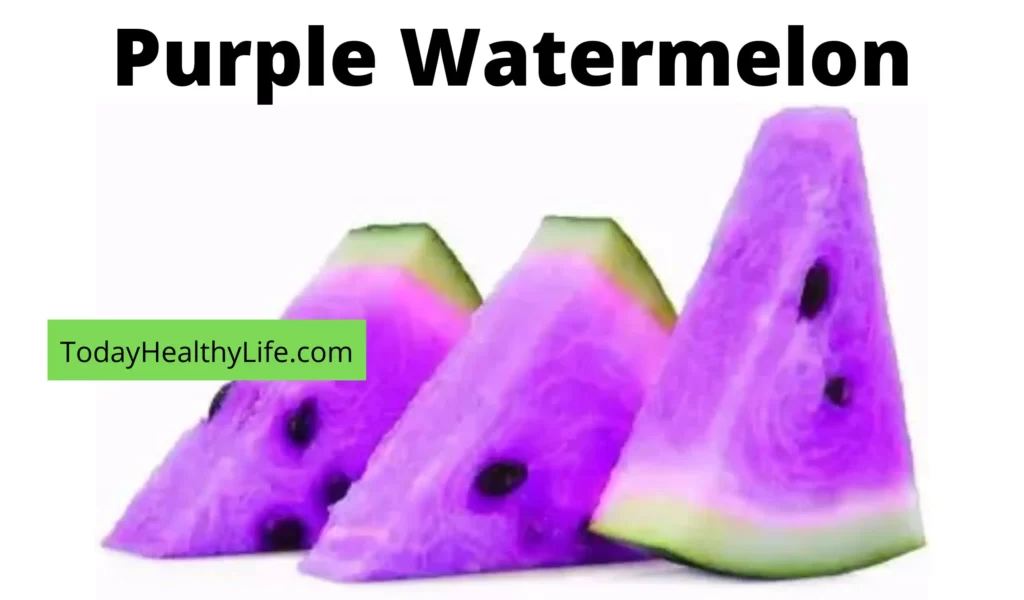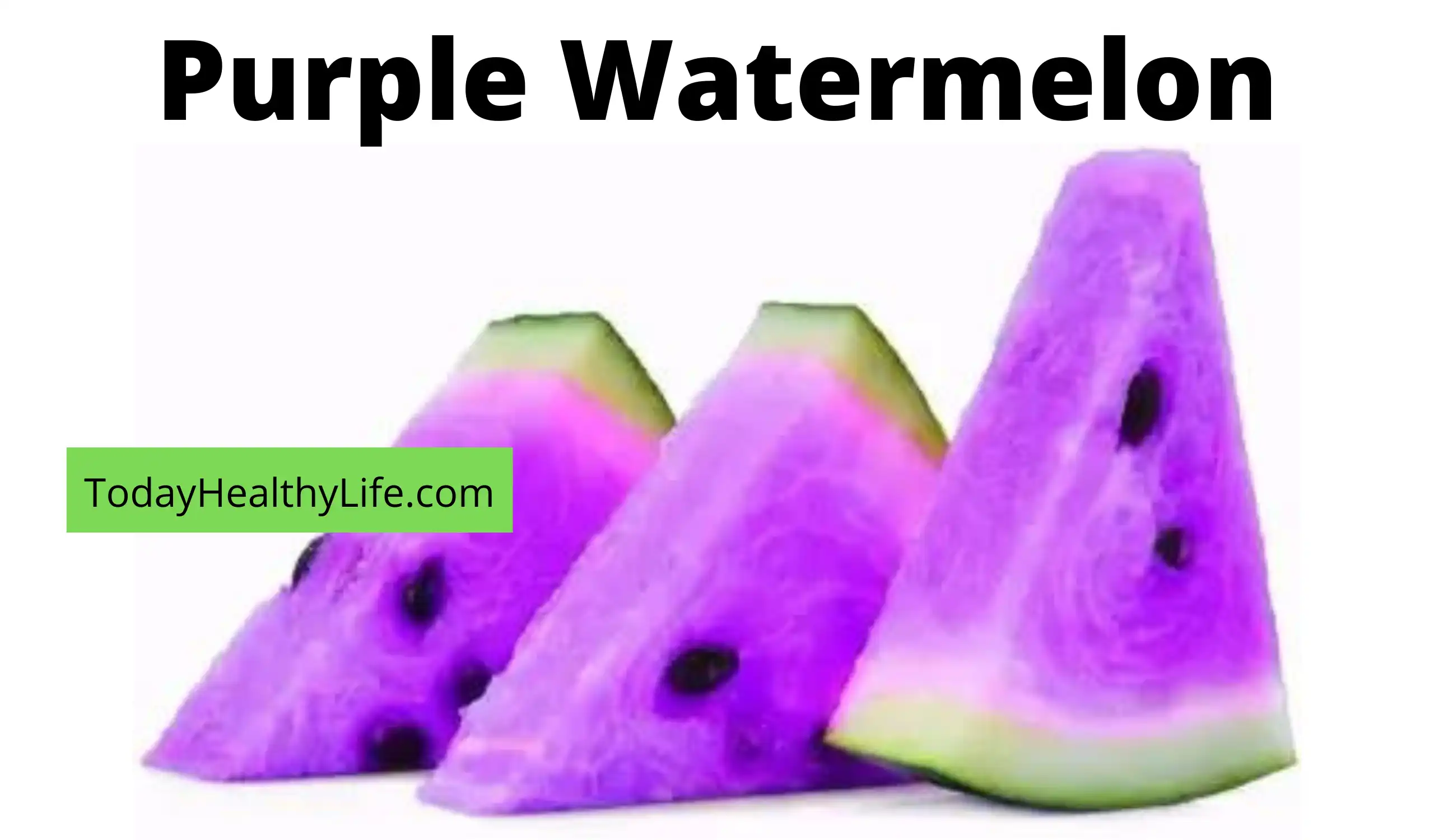Purple watermelon has recently garnered attention, intriguing many with its captivating hue.
While the idea of a purple watermelon is fascinating, it is crucial to understand that purple watermelons, unfortunately, do not exist in nature.
The concept of purple watermelons has been the result of clever photo manipulation and deceptive advertising.
In this comprehensive blog post, we will delve into the myth of purple watermelons, explore the reasons behind the deception, and discuss the benefits and side effects of actual red-fleshed watermelons.
Additionally, we will provide exciting recipes to enjoy this refreshing and nutritious fruit.

Table of Contents
What is a purple watermelon?
There is no such thing as a purple watermelon. The images of purple watermelons that you may have seen online are photoshopped. The color purple is not naturally found in watermelon flesh.
The color of watermelon flesh is determined by the amount of lycopene, a red pigment, that is present. Watermelons with a deeper red flesh have more lycopene.
There are some watermelons that have a slightly purplish tint to the flesh, but this is due to the presence of anthocyanins, which are pigments that give plants their blue, purple, and red colors.
However, the flesh of these watermelons is still red, not purple.
So, if you’re looking for a purple watermelon, you’re out of luck. But there are other types of watermelons with unique colors and flavors that you can try.
For example, black watermelons have a slightly deeper red flesh and a slightly sweeter flavor than regular red watermelons.
Yellow watermelons have a yellow flesh and a slightly milder flavor than red watermelons. And orange watermelons have an orange flesh and a slightly tangy flavor.
No matter what type of watermelon you choose, you’re sure to enjoy its refreshing taste and juicy flesh.
Also Read:
- Pepino melon benefits, nutrition, how to eat, taste & more.
- Horned Melon Side Effects, Benefits, Recipes, How To Eat, Taste & All.
Is purple watermelon real?
No, purple watermelon is not a naturally occurring fruit. It is essential to understand that any claims or images of purple watermelons are most likely the result of photo manipulation or deceptive advertising.
While watermelons come in various natural flesh colors, such as red, yellow, orange, and white, there is no authentic variety of watermelon with purple flesh.
The concept of purple watermelons gained popularity through edited images and false claims on the internet and social media, leading many people to believe in their existence.
Furthermore, there have been instances of hoax seeds being sold online, marketed as “purple watermelon” seeds that would allegedly grow watermelons with purple flesh.
However, these seeds have been shown to produce only regular red-fleshed watermelons, confirming the deception.
Until there is credible and verifiable evidence from reputable sources regarding the existence of genuinely purple-fleshed watermelons, it is safe to conclude that purple watermelons are not real and remain a product of misinformation and photo manipulation.
Always be critical and cautious when encountering extraordinary claims or images on the internet.
Is purple watermelon natural?
No, there is no naturally occurring purple watermelon. Watermelons typically come in a range of natural flesh colors, including red, pink, orange, yellow, and white, but not purple.
As we mentioned above, the concept of purple watermelons has been perpetuated through edited images, deceptive advertising, and hoax seeds sold online, leading many people to believe in their existence.
However, it is crucial to understand that any claims or images of purple watermelons are most likely the result of photo manipulation and not a representation of a real fruit.
While advances in agriculture and breeding techniques have allowed for the development of new watermelon varieties, there was no confirmed authentic purple-fleshed watermelon available in the market.
Always be cautious of misleading information and verify the authenticity of claims before accepting the existence of any rare or unique varieties of fruits or vegetables.
What does purple watermelon taste like?
Many people say purple watermelon has a sweet and slightly tart flavor that is often described as being similar to a cross between a traditional watermelon and a honeydew melon. But this information is totally false.
As we already mentioned purple watermelon does not exist as a naturally occurring fruit. Therefore, it is not possible to describe the taste of purple watermelon since there are no authentic purple-fleshed watermelons available.
Nutrition
Here is the nutrition chart of 250g red-fleshed watermelon:
| Nutrient | Amount | % Daily Value |
|---|---|---|
| Calories | 75 | 3% |
| Total Fat | 0.4g | 1% |
| Saturated Fat | 0g | 0% |
| Cholesterol | 0mg | 0% |
| Sodium | 2mg | 0% |
| Total Carbohydrates | 18.9g | 6% |
| Dietary Fiber | 1g | 4% |
| Sugar | 15.5g | 18% |
| Protein | 1.5g | 3% |
| Vitamin C | 15.2mg | 25% |
| Vitamin A | 45mcg | 2% |
| Lycopene | 4500mcg | 225% |
| Potassium | 420mg | 10% |
As you can see, watermelon is a very low-calorie food that is high in water and nutrients. It is a good source of vitamin C, vitamin A, and lycopene.
Lycopene is an antioxidant that has been linked to a number of health benefits, including reduced risk of heart disease, cancer, and other chronic diseases.
Watermelon is also a good source of potassium, which is an important mineral for heart health.
It is also a good source of dietary fiber, which can help to regulate digestion and promote gut health.
Health benefits
While purple watermelons may be a hoax, red-fleshed watermelons are a real and nutritious fruit with numerous health benefits.
Let’s explore some of the advantages of consuming red-fleshed watermelons:
- Hydration: Watermelons have a high water content, making them an excellent fruit to stay hydrated, especially during hot summer months.
- Rich in Nutrients: Red-fleshed watermelons are packed with essential vitamins, including vitamin C, vitamin A, and vitamin B6. They also contain minerals like potassium and magnesium.
- Antioxidant Properties: Watermelons are rich in antioxidants like lycopene and beta-carotene, which help combat oxidative stress and reduce the risk of chronic diseases.
- Heart Health: The presence of citrulline in watermelons helps maintain healthy blood pressure levels and promotes heart health.
- Weight Management: Watermelons are low in calories and fat, making them a great addition to a weight management diet.
How to eat watermelon?
All watermelons are a refreshing summer treat, and there are many different ways to enjoy them.
One of the most popular methods is to simply slice the watermelon into wedges and eat it as is. However, if you’re looking for a more creative way to enjoy this tasty fruit, here are some tips on how to eat this melon.
One option is to cut the watermelon into small cubes and add them to a salad. The sweetness of the watermelon will help to balance out the bitterness of the greens, and the bright color will add a touch of visual appeal.
Another idea is to blend it with other fruits and vegetables to create a healthy smoothie. This can be a great way to start your day or refuel after a workout.
Finally, if you’re feeling adventurous, you can use this melon in place of tomatoes in a classic Caprese salad. The combination of sweet melon, creamy mozzarella, and fragrant basil is sure to please your taste buds.
So no matter how you choose to eat it, watermelon is a delicious and nutritious option that is perfect for summertime enjoyment.
Watermelon recipes
If you’re looking for more ways to enjoy natural watermelon, here are some recipes to get you started.
Salad
This salad is a refreshing and easy-to-make option that is perfect for a summer picnic. It combines cubed watermelon with feta cheese, mint leaves, and balsamic vinegar.
Smoothie
This smoothie is a great way to start your day or refuel after a workout. It combines watermelon, banana, almond milk, and chia seeds.
Salsa
This salsa is a perfect accompaniment to grilled chicken or fish. It combines cubed watermelon with diced cucumber, red onion, jalapeno pepper, and lime juice.
Caprese Salad
This salad is a unique twist on the classic Caprese salad. It combines cubed watermelon, mozzarella cheese, and basil leaves.
Be sure to add it to your grocery list and enjoy the many benefits it has to offer.
Who should eat watermelon?
Watermelon is a delicious and nutritious fruit that can be enjoyed by a wide range of people as part of a healthy diet.
It is a hydrating and refreshing fruit with numerous health benefits.
Here are some groups of people who can benefit from eating watermelon:
- Everyone: Watermelon is a safe and healthy fruit for people of all ages, including children and adults. It can be a great addition to a balanced diet.
- Hydration: Watermelon has a high water content, making it an excellent choice for staying hydrated, especially during hot weather or after physical activity.
- Weight Management: Watermelon is low in calories and fat, making it a suitable option for those looking to manage their weight while satisfying their sweet cravings.
- Athletes: Due to its hydrating properties and natural sugars, watermelon can be a good choice for athletes or those engaging in physical activities to replenish fluids and provide quick energy.
- Pregnant Women: Watermelon contains essential nutrients like vitamin C, vitamin A, and potassium, which can benefit pregnant women and support fetal development.
- Heart Health: The presence of citrulline in watermelon helps support heart health by promoting healthy blood pressure levels.
- Digestive Health: Watermelon contains dietary fiber, which can aid in digestion and support a healthy digestive system.
- General Health Benefits: Watermelon is a rich source of antioxidants, including lycopene and beta-carotene, which can help reduce oxidative stress and lower the risk of chronic diseases.
While watermelon is generally safe for most people, those with certain medical conditions or allergies should consult their healthcare provider before making significant changes to their diet.
People with diabetes should also be mindful of their carbohydrate intake, as watermelon contains natural sugars.
In summary, watermelon is a refreshing and nutritious fruit suitable for almost everyone.
Including it in a varied and balanced diet can contribute to overall health and well-being.
How to make or grow watermelon?
Growing watermelons can be a rewarding experience, and it’s relatively simple with the right conditions and care.
Here’s a step-by-step guide on how to grow watermelon:
- Choose the Right Variety: Select a watermelon variety that suits your climate and growing conditions. Some varieties are better suited for hot and dry climates, while others may be more resistant to certain diseases.
- Prepare the Soil: Watermelons thrive in well-draining, sandy loam soil rich in organic matter. Prepare the soil by tilling it to a depth of at least 12 inches and adding compost or well-rotted manure to improve fertility.
- Sow the Seeds or Transplant Seedlings: Watermelons can be grown from seeds sown directly in the ground or started indoors as seedlings. If sowing directly, plant the seeds in hills or mounds, about 1 inch deep and 3-4 feet apart. If starting as seedlings, transplant them outdoors once the danger of frost has passed and the soil is warm.
- Provide Adequate Space: Watermelon vines spread extensively, so make sure to provide enough space between plants, at least 3-4 feet apart, to allow them to grow freely.
- Watering: Watermelons need consistent and deep watering, especially during dry spells. Water at the base of the plant to avoid wetting the leaves, which can promote fungal diseases.
- Mulch: Apply a layer of organic mulch around the plants to help retain soil moisture, suppress weeds, and keep the fruit clean.
- Support the Fruit: As the fruit begins to develop, you may want to support it to prevent damage to the vine. You can use slings made of fabric or pantyhose to support the growing watermelons.
- Fertilization: Watermelons are heavy feeders. Fertilize the plants with a balanced fertilizer or a fertilizer specifically formulated for fruits and vegetables, following the manufacturer’s instructions.
- Pest and Disease Control: Monitor your watermelon plants regularly for any signs of pests or diseases. Treat any issues promptly using organic or chemical methods, if necessary.
- Harvesting: Watermelons are ready for harvest when the fruit’s underside turns creamy yellow and the stem starts to dry out. Give the fruit a gentle thump; a ripe watermelon will produce a deep, hollow sound. Cut the fruit from the vine with a sharp knife or shears, leaving a short stem attached.
Growing watermelon requires patience and attention, but with proper care and ideal growing conditions, you can enjoy sweet and juicy homegrown watermelons throughout the summer!
Side effects of watermelon
As with any food, there is the potential for side effects when eating watermelon. The most common side effect is an upset stomach.
This can happen if you eat too much watermelon or if you have a sensitive stomach.
If you experience nausea, vomiting, or diarrhea after eating watermelon, it’s best to stop consuming it and see if your symptoms improve.
Other less common side effects of watermelon include:
Allergic reaction
Some people may be allergic to watermelon. If you experience any symptoms of an allergic reaction, such as hives, swelling, or difficulty breathing, stop eating watermelon and seek medical attention immediately.
Interaction with medications
Watermelon may interact with certain medications, such as blood pressure and diabetes medications. If you are taking any medications, it’s best to speak to your doctor before eating them.
Digestive problems
Eating large amounts of watermelon may cause digestive problems, such as gas or bloating. If you experience these symptoms, try eating smaller amounts of watermelon or avoid eating it altogether.
Overall, watermelon is safe to eat in moderation. If you experience any side effects after eating it, such as an upset stomach, it’s best to stop consuming it and see if your symptoms improve.
As with any food, some people may be allergic to it. If you experience any symptoms of an allergic reaction, such as hives, swelling, or difficulty breathing, stop eating it and seek medical attention immediately.
Some related FAQ:
Yes, watermelon is safe to eat. It is a nutritious and delicious option for everyone. Everyone can choose this delicious and healthy option. However, those who want to increase their consumption of antioxidants and vitamins A and C may find it to be very helpful. Watermelon is also a low-calorie item that can aid in weight loss or weight maintenance. Therefore, watermelon is a fantastic complement to your diet, regardless of your health objectives.
Yes, you can grow your own watermelon. Look for seeds at your local garden center or online. Once you have the seeds, plant them in well-drained soil in an area that gets full sun. Water the melon plants regularly and fertilize them every few weeks. When the watermelons are about the size of a soccer ball, it’s time to harvest them. Enjoy your homemade watermelons within a few days for the best flavor and nutritional value.
To choose a good watermelon, look for a firm, symmetrical fruit with a uniform shape and smooth, unblemished skin. Tap the watermelon; a ripe one will produce a deep, hollow sound. Check for a creamy yellow spot on the bottom, indicating ripeness.
Conclusion
While purple watermelons may have captured our imaginations, they remain a product of photo manipulation and deceptive advertising.
However, this should not overshadow the benefits and deliciousness of red-fleshed watermelons, a truly delightful and nutritious fruit.
As consumers, it is essential to be cautious and critical of information presented online. Embrace the vibrant red watermelon for its exceptional taste, health benefits, and versatility in various culinary creations.
Enjoy the summer season with this refreshing fruit and its delightful recipes.

